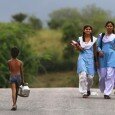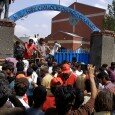By Zulfiqar Kunbhar –
While dwellers of Thar are dying with hunger and thirst, the baboos of Sindh government are making and wasting money through ill-planned Reverse Osmosis Water Plants
Had Marvi got water at her doorstep, folklore ‘Umer-Marvi’ would not crop up. Umer, prince of Umerkot, lift Marvi – a common girl of Bhaalwa village of Tharparkar – when she was drawing water from a well.
But the luxuries of the palace could not impress Marvi as she pined for her home. Finally Umer gave up and set her free. Umer’s name would be enlisted to those rulers who did not provide water to ever-thirsty Tharis. Perhaps Umer had left the development work to the future rulers. Hundred years down the line the situation is same in Tharparkar Desert as the most of remote areas of Sindh province are waterless.
With 22,000 square-mile sprawl of sand dunes, Sindh’s southern bordering district Tharparkar, some 420 kilometers away from Karachi-via-Hyderabad is facing trademark brutality of third consecutive year of drought like chronic poverty,malnutrition, diseases, mother-child mortalities, seasonal migration and vulnerability for the population, thanks to the least-bothering government.
The three-year drought has cost not less than 1150 reported children deaths, mostly less than five years of age, due to malnutrition. In the said period around 100 persons committed suicide mostly on hunger related-causes. Death toll of cattle that remain the main source of income for locals has reached 0.4 million, among them 0.35 million only sheep. Among the total population of 1.5 million, around 0.4 million Tharis migrate annually along with their 4 million cattle heads in search of food and fodder.
The people of mighty desert are between the frequent droughts and reactive rather than proactive government whose partial immunity actions are often coated with corruption allegations. According to estimations, Rs 6 billion would be spent on designed 750 Reverse Osmosis (RO) plants to be installed for purifying brackish ground water in Tharparkar. It is estimated that each plant in Tharparkar costs from Rs 7.5 million to Rs 20 million, depending upon the capacity. Among locals, there are strong fears that in long term whole exercise could be fruitless. They fear that it will only benefit some ‘favourite’ individuals, as the majority of existing 75 RO plants are not functioning.
Pique visited one such plant installed at Bakuo village of Mithi taluka, where a group of women following their routine were collecting water from nearby water-wells, as the plant water was unfit to drink. Area people informed that water was causing diarrhea. Two more plants are under-construction in the same village, whose population consists of five thousand people. Despite the availability of electricity in the village the plant has been denied of the power connection. “The plant water is being used for washing purpose only. If million-rupees-worth plant water is unsafe then it is simply the waste of money,” said Timoo, a 50 years teacher who was present at plant to fetch water for his family. “There are already fifteen wells in the area. They say an engineer is required to make the water drinkable but there is no engineer hired here,” Timoo said as nearby standing watchman cum plant operator Ghulam Rasheed Dars confirmed he was the sole employee deployed here. “Around 150 liters diesel is required weekly for one RO plant, whereas per day diesel consumption is around 40 liters. Plant is run on alternate days – three days a week,” Rasheed said.
Rules regarding the minimum staff hiring require technical and generator operators at every RO plant, are not being followed at most of plants resulting the non-potable water for locals.
Another dweller present to fetch water was Qeemat Meghwar, 21 years old unmarried boy, who complained about non availability of water connection to homes through plant. “This is my ninth turn to collect water in a single day. The job of fetching water needs at least two persons, one each for pulling and collecting in pot,” said Qeemat. “I am a labourer and most of time my daily wage is gone waste because of water collecting,” Qeemat said while holding two plastic buckets as he proceeded towards donkey, tied-up outside plant-boundary walls for lifting water. Each family is restricted to carry ten ‘pakhaal’ (four water cans) of water per day.
“There are several serious questions on the design, capability and most important real motive behind the installation of RO plants,” said Ali Akbar Rahimoo, Executive Director of Water, Applied Education and Renewable Energy (AWARE), an NGO working in Thar.
“Unfortunately RO plant scheme has earned negative publicity, often criticised for involvement of some political high-ups,” said Rahimoo, also a social activist and researcher. RO plants once imported from Dubai were introduced in year 2007 are now being made locally. Interestingly in various villages where electricity is available, the plants are still being run on diesel like we saw in Bakuo village. “Certainly Tharparkar has turned into a graveyard of mega projects,” said Rahimoo.
“Some plants are installed where sweet water is available, so it makes no sense,” he stated adding that although promised, no laboratory has been set up in district headquarters Mithi for checking water quality. “The question is what would be maintenance level if all 750 RO plants were built since plants that already exist cannot be maintained properly,” Rahimoo opined.
It is accused that Rs 12 million monthly or Rs 0.4 million per day are being dragged to ‘black hole’ in the name of maintenance, fuel and ‘ghost’ employees of RO plants.
Then there are installations of RO plants on political favouritism basis too avoiding the requirements. “In some cases people of 80 homes of nearby village would have to travel to four houses village where RO plant is installed. The sustainability of RO plants is a question mark for future. It is likely in longer droughts there would always a possibility of RO plants getting dry in case of depleting water table,” said Rahimoo.
Sindh government claims it is spending Rs 4 billion on the distribution of free wheat and 10 billion on roads infrastructure in the waterless Tharparkar. The government spends additional amount for the transportation charges of grain and provision of mineral water. But there is no permanent solution for Tharparkar water issue.
According to experts, providing water in desert like Thar could be a daunting and ultimate task but the governments, both present and former, have ignored and did not show special attention toward the water delivery. The solution according to experts lies in the form of digging canals.
A new canal can be built along with Kas (near Morano, Tharparkar) and also old course of Hakro called Dhoro can be revived in this regard, said Professor Noor Ahmed Janjhi an area water expert.
According to Professor, another way of providing water to Tharparkar is stretching Mithrao-Jamrao canal from Mirpurkhas towards Thar. British rulers dug out Mithrao Jamrao canal in 1906 to water old Tharparkur, which at that time included Mirpurkhas, Sanghar, Umerkot and Tharparkar.
Apart from digging new canals, some existing pipelines could be improved, added Janjhi. One such line is that comes from Naukot waters till Islamkot passing Mithi. From Islamkot the line could be further stretched to Nangarparkar. One pipeline that is nonfunctional since 2011 passes from Kaloi towards Diplo taluka, needs the authorities’ immediate attention for reopening, he told Pique. There exist four pipelines in Tharparkar. One active line that is watered from Thar Wah comes from Chor and proceeds towards Kheesar. Another active pipeline comes from Cheel Band and waters Chhachharo.
The incompetence and lack of interest of present and previous governments could not provide water even after 67 years of country’s existence unlike India who dug out Indira Gandhi Canal in 1958 for Rajhasthan Desert. The main objective behind building the canal was to convert Indian part of Thar Desert from wasteland to agriculturally productive area. Pakistan is possessing 30 percent of the total Thar Desert area while remaining is in Indian Territory. The Great Thar Desert of bordering country India faces naturally same intensity of drought but situation does not go bad to this extent, thanks to 650 kilometers long Indira Gandhi Canal, formerly called Rajasthan Canal.
There are some dams in areas of Tharparkar mostly in Nangarparkar. We are not utilizing them for effective rainwater harvesting. There are around sixteen bourns (nadiyan) run in Nangarparkar. Check dams could be constructed in the district. Dams like Raanpur and Sukhpur were constructed in Nangarparkar during Pervez Musharaf era. There is also natural lake named ‘Sangha’ which has now dried up. In Kaasbo village in Nagarparkar taluka, locals cultivate their lands through tube wells. They cultivate wheat, chili, onion and others vegetables. There are around fifteen hundred homes in the village.
The dam Pique visited is at Bhudesar Nangarparkar, situated at the background of historical Bhudesar Mosque. Although water was polluted, cows, goats, sheep and donkeys were busy in gulping it greedily inside empty dam’s boundaries. This was natural dam surrounded by natural walls but now it has been stone pitched. Stone pitching was done in 1990s while repairing was also done last year. There is a myth regarding the dam that is described in Hothal parri dastan.
According to myth when parries (fairies) used to wash their faces the water would have turned into some colour. This dam is included in old dams of Nangarparar. During good rain spells, the dam has capacity to fill in yearlong water necessity. There were around herdsmen present with their cattle. Sarto Charan (herdsman) said he came from a nearby village Dainsi. “What else could we do? We have to feed our animals with this polluted water as other water resources are scared,” Sarto Charan added.
“Tharparkar has long history of terrible droughts,” said Khatau Jani senior local journalist. “But what makes the Desert a unique case is so far it has not been provided permanent solution. Current Chief Minister Sindh Qaim Ali Shah led Pakistan People’s Party’s government in its two consecutive terms has restricted itself to only some cosmetic steps,” he added. According to Khatau national policy was announced in September 2009 however no provincial policy has been announced regarding water scare areas. “Government has failed to present water security plan for Thar. We heard about government’s plan for Tharparkar Development Authority but didn’t see any practical step. Where is Tharparkar drought policy,” he asked.
Entering in the seventh consecutive year in Sindh, PPP also ruled country from 2008-2013 in centre. Advisor to Chief Minister Sindh and in charge of relief activities in Tharparkar, Taj Haider said provincial government was seriously working on permanent solution of Thar’s water problems. According to him around 225 plants would start operating by end of this year. “All new plants being installed are solar-powered plants. Till July 2015 total 750 RO plants will be installed in Thar Desert,” Haider added. Asked about any possibility of digging out canals, his answer was: “Where is water? Even people of tail-enders like Badin are unable to find water, how could we supply the water to Tharis through canals?” he bluntly responded.
While we see incapable government in the province, we also do not see the presence of federal government as far as Tharparkar drought is concerned. If federal government can be involved making planning when it comes to the coal project why can not it take its part in Thar drought?
Thar water is contaminated and contains arsenic, which causes abdomen related diseases and other fatal ailments. According to World Health Organization (WHO) standards, 1,000 ppm is considered safe drinking water. The people of Tharparkar are drinking water of 3,000-4,000 ppm.
Marvi couldn’t get water at her doorstep, that is a tale of past now. But when Tharis of today’s ‘modern world’ would quench their thirst is the million-dollar-question. May be the ruling elite have any answer.
![]() The writer is a Karachi based journalist and works for Daily Times
The writer is a Karachi based journalist and works for Daily Times






























































































